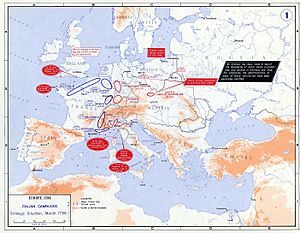War of the First Coalition facts for kids
Quick facts for kids War of the First Coalition |
|||||||||
|---|---|---|---|---|---|---|---|---|---|
| Part of the French Revolutionary Wars and the Coalition Wars | |||||||||
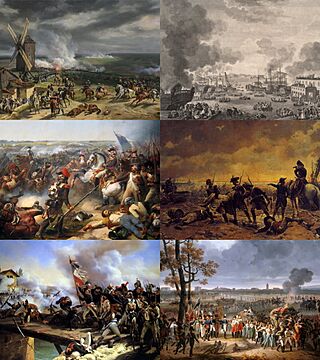 Click an image to load the appropriate article. Left to right, top to bottom: Battles of Valmy, Toulon, Fleurus, Quiberon, Arcole and Mantua |
|||||||||
|
|||||||||
| Belligerents | |||||||||
|
First Coalition
|
|
||||||||
| Commanders and leaders | |||||||||
|
|||||||||
| Strength | |||||||||
| 1793: |
|
||||||||
| Casualties and losses | |||||||||
94,000 soldiers killed in combat ~188,000 died of disease 220,000 captured 100,000 wounded |
100,000 soldiers killed in combat ~200,000 died of disease 150,000 captured |
||||||||
The War of the First Coalition was a series of wars fought between 1792 and 1797. Many European countries, like Austria, Prussia, and Great Britain, joined forces against France. These countries formed a group called the First Coalition. They were worried about the changes happening in France during the French Revolution.
In 1791, some European leaders issued the Declaration of Pillnitz. This statement warned France about harming its royal family. France saw this as a threat. So, on April 20, 1792, France declared war on Austria. Soon after, Prussia also declared war on France.
An army from Austria and Prussia invaded France in July 1792. This invasion caused great unrest in Paris. However, the French army won an important battle at Valmy in September. This victory boosted French morale. Two days later, France became a republic.
Over the next few years, the Coalition tried to invade France many times. Great Britain supported rebellions inside France. France faced tough challenges, including internal conflicts. To fight back, France created the Committee of Public Safety. It also started a "levée en masse", which meant calling many young men to join the army. These new French armies pushed back the invaders and even advanced into other countries.
France created new republics in lands it conquered, like the Batavian Republic. It also made peace treaties with some enemies, such as Prussia and Spain. Napoleon Bonaparte became a famous general during this time. He led successful campaigns in Italy against Sardinia and Austria. By October 1797, Austria signed the Treaty of Campo Formio, ending the First Coalition. Only Great Britain remained at war with France.
Contents
Why the War Started
Changes in France
The French Revolution began in 1789. Other royal families in Europe watched these events with worry. They thought about getting involved to help King Louis XVI or to benefit from the chaos.
Leopold II, Holy Roman Emperor, was the brother of France's Queen Marie Antoinette. He was initially calm about the Revolution. But he grew more concerned as the changes in France became more extreme.
The Pillnitz Declaration
On August 27, 1791, Emperor Leopold and King Frederick William II of Prussia made a statement. It was called the Declaration of Pillnitz. They said they were worried about King Louis XVI and his family. They also warned of serious consequences if anything bad happened to them.
French leaders saw this declaration as a major threat. They believed other countries were trying to interfere.
France Declares War
There were also disagreements about French lands near Germany. French leaders were also concerned about French nobles who had left France. These nobles, called émigrés, were trying to stir up trouble from other countries.
Finally, France decided to act first. On April 20, 1792, the French Assembly voted to declare war on Austria. They believed war was necessary to protect the Revolution.
Battles of 1792
Early French Struggles
France tried to invade the Austrian Netherlands (modern-day Belgium). However, the French army was not well-organized. Many soldiers ran away or deserted. This made the early part of the war very difficult for France.
Meanwhile, an army of Austrian and Prussian soldiers gathered. Their leader was the Duke of Brunswick. In July 1792, they invaded France.
The Brunswick Manifesto
The Duke of Brunswick issued a strong statement. It said he wanted to restore the French King's full power. He also threatened to punish anyone who resisted. This threat made the French people even more determined to fight. It also led to the King being removed from power.
The Battle of Valmy
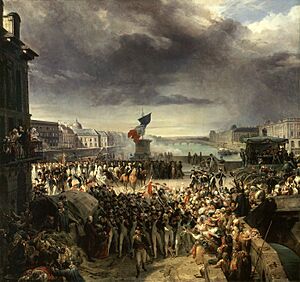
The Prussian army advanced into France. They captured some fortresses. But on September 20, 1792, they met the French army at the Battle of Valmy. The French artillery (cannons) fought very well.
The battle ended in a draw, but it was a big win for French morale. The Prussians decided the war would be too long and costly. They chose to retreat from France.
French Successes Elsewhere
While the Prussians retreated, France had successes in other areas. French forces occupied parts of Italy, like Savoy and Nice. General Custine also invaded Germany. He captured cities like Speyer and Mainz along the Rhine river.
Later in 1792, the French general Dumouriez attacked the Austrian Netherlands again. He won a major victory at the Battle of Jemappes in November. This allowed France to take control of the entire region.
Events of 1793
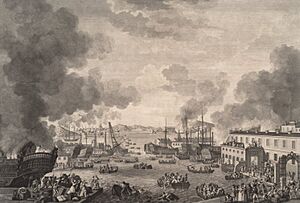
On January 21, the French government executed King Louis XVI after a trial. This event shocked many European leaders. It led more countries to join the fight against France.
Soon, Spain, the Dutch Republic, and other nations declared war on France. Great Britain also joined the Coalition. This officially formed the First Coalition, a large alliance against France.
New Soldiers for France
France needed more soldiers to fight so many enemies. So, it started a new policy called levée en masse. This was a mass draft, calling up hundreds of thousands of young men to join the army. This allowed France to have a much larger army than its enemies.
France also tried to get the United States to join the war. However, the U.S. chose to remain neutral.
Key Battles
The Austrians won a battle at Neerwinden in March. But later, the French won important victories at Wattignies and Wissembourg. British forces were defeated at the Battle of Hondschoote in September.
Campaigns of 1794
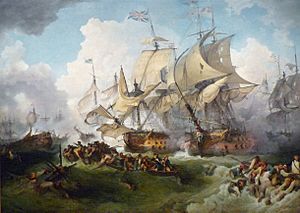
Battle of Fleurus
The year 1794 brought more success for the French armies. A major victory at the Battle of Fleurus helped France gain control of the Austrian Netherlands and the Rhineland.
The British navy remained strong at sea. However, they could not support land operations effectively after France took Belgium. The Prussians slowly left the war. By the end of the year, they were no longer actively fighting. France also had success against Spain in the War of the Pyrenees.
Fighting in the West Indies
The war also reached French colonies in the West Indies. A British fleet captured Martinique, St. Lucia, and Guadeloupe. But a French fleet arrived later and took back Guadeloupe.
Events of 1795
France Takes the Low Countries
France launched a surprise winter attack and captured the Low Countries. They then set up the Batavian Republic, a new state controlled by France.
Prussia officially left the war on April 5, 1795. They signed the Peace of Basel with France. This treaty recognized France's control of the land west of the Rhine river. The new Dutch government also gave up some territory for peace. Spain signed a separate peace treaty with France in July. These agreements meant France was safe from invasion for many years.
Rebellions and New Leadership
Great Britain tried to help rebels in the Vendée region of France. They landed French Royalist troops at Quiberon, but this effort failed.
In Paris, attempts to overthrow the government were stopped by military forces. Napoleon Bonaparte played a key role in putting down these uprisings. This led to the creation of the French Directory, a new government for France.
Campaigns of 1796
France planned a big attack on three fronts. Generals Jourdan and Moreau led armies along the Rhine river. The newly promoted General Napoleon Bonaparte led an army in Italy. Their goal was to meet in Tyrol and march on Vienna, the capital of Austria.
Rhine Campaign
Generals Jourdan and Moreau crossed the Rhine river into Germany. Jourdan advanced far into Germany, and Moreau reached Bavaria. However, Archduke Charles, Duke of Teschen, an Austrian general, defeated Jourdan. Both French armies had to retreat back across the Rhine.
Napoleon's Invasion of Italy
Napoleon, however, was very successful in Italy. In the Montenotte Campaign, he cleverly separated the armies of Sardinia and Austria. He defeated each army one by one.
Napoleon then forced Sardinia to sign a peace treaty. His army captured Milan and began the Siege of Mantua. Napoleon defeated several Austrian armies sent to stop him while he continued the siege.
End of the Vendée Rebellion
The internal rebellion in the Vendée region was finally crushed in 1796. This brought an end to a long and difficult conflict within France.
Final Year: 1797
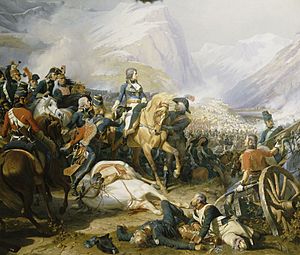
Mantua Falls and Austria Seeks Peace
On February 2, Napoleon finally captured Mantua. The Austrian forces there surrendered 18,000 soldiers. Archduke Charles of Austria could not stop Napoleon from invading Tyrol. Because of these losses, the Austrian government asked for peace in April. At the same time, new French armies invaded Germany.
French Landing in Britain
On February 22, a small French force landed near Fishguard in Wales. These 1,400 troops were part of "The Black Legion." They were met by British reservists, militia, and sailors. After some small fights, the French commander was forced to surrender on February 24. This was the only battle fought on British soil during these wars.
The Treaty of Campo Formio
Austria signed the Treaty of Campo Formio in October 1797. This treaty gave Belgium to France. It also recognized French control over the Rhineland and much of Italy. The old Republic of Venice was divided between Austria and France.
This treaty officially ended the War of the First Coalition. However, Great Britain and France remained at war with each other.
See also


